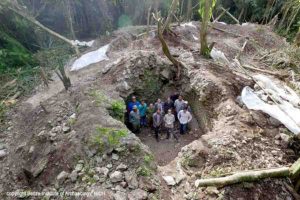
Deep in the untamed lowlands, we search for artifacts buried under hundreds of years of sediment. We are excavating two ancient Maya sites nestled in the sacred landscape of Cara Blanca in central Belize. Both date to A.D. 800-900, when prolonged and severe droughts struck this region, disrupting the daily life of the Maya.
These two structures – a platform teetering on the edge of a 60-meter-deep pool and a sweatbath compound – were part of a ritual pilgrimage circuit traversed by the ancient Maya to pay tribute to the rain god Chahk during the extended droughts.
Openings in the earth like this pool were thought to be portals to the underworld, places where deities and ancestors resided. In previous years studying this poolside platform, we discovered a massive burning event and thousands of ceramic sherds purposely placed on the plaster floor.
Burnings and offerings of this nature were a common practice with the ancient Maya. These were part of termination rituals, meant to “deanimate” objects or spaces and remove them from the life cycle. Everything was believed to contain a life force, making deanimation a critical process for the Maya.
Our aim this year is to garner a deeper understanding of this ritual space. We scrape away at the soil, trowel by trowel, filling buckets and sifting each one to avoid missing any bit of data. The deeper we go, the harder it becomes to hoist the dirt out of this trench.
It isn’t long before we unexpectedly uncover another platform. The ceramics at this layer seem to be from a much earlier time period – about A.D. 600! This suggests the Maya were ritually engaging with the Cara Blanca landscape before the drought period began – much earlier than we anticipated.
This older, deeper platform has thin floors and few walls. No human remains are buried here. This might reflect a wetter, less socially trying time.
As we walk from the trench to a sweatbath compound 10 minutes away, tiny pink petals fallen from flowering trees paint the walkways. The sweatbath appears heavily looted; our goal is to salvage whatever information remains. But when we start to excavate, we find no looters’ debris. We also find no large stones, which are usually present in a building collapse. This suggests the Maya dismantled this structure themselves during a termination ritual prior to their total abandonment of the area.
As we leave the site, driving off-road for 20 minutes down a rocky ravine, we ponder the importance of Cara Blanca to the ancient Maya. The intense effort they made to build and terminate these structures may reflect just how dire their circumstances were in the time of the droughts.
Note: The above post is reprinted from materials provided by University of Illinois at Urbana-Champaign.










